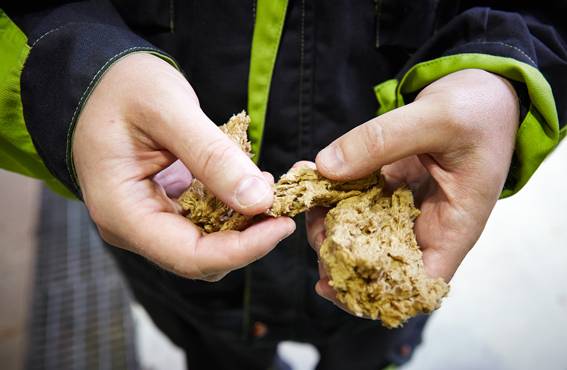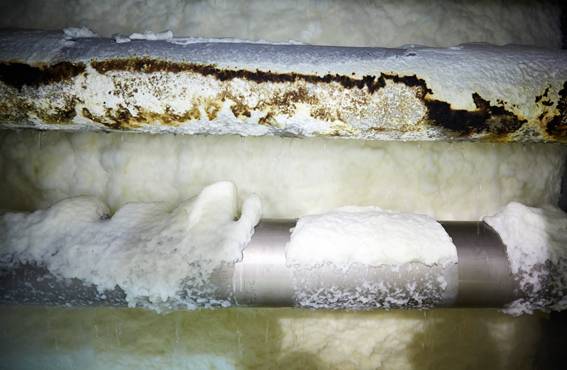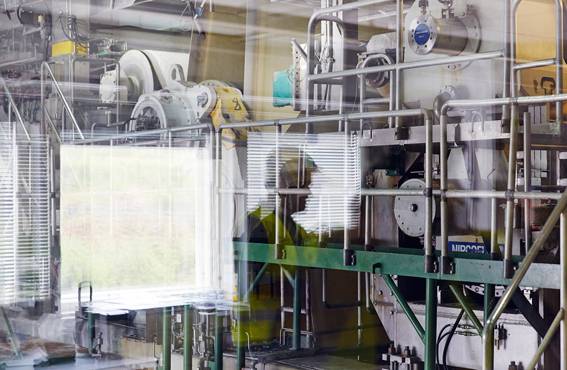The era of new leadership
Kuvateksti: Camilla Wickström is the managing director of the present chemical pulp mill at Äänekoski, and also of the new bioproduct mill that will replace the old one. She believes in delegating responsibility to the employees – her leadership philosophy is based on trust.
Authoritative orders no, dialogue yes. A new kind of leadership is needed as work life and job descriptions change. In the work community of the new millennium, open communication and listening to the workers improve people’s motivation, productivity, and well-being at work. The employees at the pulpwood mill in Äänekoski believe in the power of discussion and feedback.
What a sweaty place! It’s hot in the production hall of the Äänekoski mill of Metsä Fibre, a part of Metsä Group Corporation. You can feel the heat as you walk with a safety helmet on your head past the huge washers of the fibre conveyor line. During the washing process, chemicals and warm water remove lignin from the wood. Lignin is the natural glue in the wood that binds the wood fibres together.
In the preparation of chemical pulp, the binding material in the wood has to be removed, and the cleaned pulp consists only of wood fibres, in other words cellulose. When clothes are laundered, hot water removes dirt better than cold, and this is also true when lignin is removed from pulpwood. The clean cellulose mass is warm and moist and resembles sticky and wet candy floss.
A warm atmosphere is present also in the control room of the factory. The work climate in the plant that employs 170 people is positive and easy-going, and the team spirit is close-knit. Camilla Wikström, managing director of the mill, comes into the control room and chats casually with the process operators of the on-going shift. Jorma Pollari and Sami Räisänen, who are monitoring production in the control room, emphasize the importance of everyday cooperation at work.
– Task rotation at the wood pulp mill ensures that everyone masters several tasks, and has learned the different phases. Cooperation and discussion improve when the workers rotate in the different tasks, says process operator Räisänen.
His colleague Pollari nods in agreement. According to him, workmates are instructed when needed and information is given freely.
– And now and then we boss each other around, Pollari grins.
The managing director’s door is always open
Openness, interaction and trust are cornerstones in the leadership of managing director Wickström. She believes in modern leadership – responsibility and power are delegated to the workers. When skilled employees, who are motivated and committed, work towards a common goal, the work is productive and the enterprise prospers. In order to share responsibility, the employees have to be willing and ready to take power and responsibility.
– My aim is to achieve discourse and interaction which is as open as possible. My door is always open, anyone can drop in to talk, and many do, says Wickström who is easy to approach.
– My own leadership philosophy is passed on to the supervisors, and by them to the entire organization.
The outside of the factory building, with its turrets, resembles a castle of a Disney fairy tale. Inside, the mill swallows up wood chips around the clock all year round. The production staff work mainly in three shifts. The operations stop only during the annual maintenance break.
The yearly production capacity of one conveyor line is 530,000 tons of ECF-bleached coniferous and deciduous pulpwood. This gives a picture of the mill’s vast scale. A thousand kilos of chemical pulp are needed to produce for instance 8600 rolls of kitchen paper towels. The total yearly amount of pulp could produce 4.6 billion rolls of paper towels.
The management model applied at Metsä Fibre is process management, which is also the method used by managing director Wickström. The management makes short-term as well as long-term plans – for one year, three years, and ten years.
– My most important task is to make sure that we focus on the right things persistently, concentrate on essentials, and know where we are heading. Our entire personnel must know our goals, says Wickström.
– Renewal is one of our values. It means continuous improvement of the mill’s operations, technology and production, environmental issues and safety matters.
A manager’s key task is to make sure that the organization does the right things, concentrates on essentials and functions persistently.

The moist and warm wood pulp resembles sticky candy floss. In the new bioproduct mill, the importance and utilization of the by-products produced in the preparation of chemical pulp will increase.
Feedback facilitates development
Interaction is promoted in many ways. A personnel survey is conducted yearly at the mill and its results are analysed; deficiencies and development targets, as well as positive factors are examined. Improvement needs, training, and goals are agreed on in the development discussions between supervisor and subordinate.
– The personnel must be given opportunities to develop their know-how. The interactive development discussions conducted by supervisors are a central tool in this, says Wickström.
She believes that feedback from the work is extremely important for everyone, also for herself. It is difficult to make improvements without feedback, and that is why praise as well as constructive criticism is needed.
– We are now learning how to give feedback. An interactive culture is still a rather new thing in Finland, but we are going in the right direction, says Wickström, who has worked for several years in Sweden.
The managing director’s advice to young people aspiring to managerial positions in the forestry industry is concise. Develop your interactive skills, listen to the people around you, and absorb information, look for broader contexts, and always try to draw the big picture. When Wickström was studying chemical technology at Åbo Akademi at the beginning of the 1990s, leadership skills were not on the curriculum.
In two decades the chemical pulp business has changed. For example, the significance of environmental and safety issues has grown continuously. Now Wickström knows they are absolute prerequisites – not to be compromised.
The next few years will bring more changes to Äänekoski. A new pulp mill is now being built to replace the old one. The production of chemical pulp will be more than doubled in the new bioproduct mill, which will start operating at the end of 2017. In future, the significance and utilization of the by-products formed in the production of chemical pulp will increase.
– The operation models will certainly change. We will build a companionship network in order to utilize the mill’s by-products. Taking care of interest group cooperation will be an important part of my work, says Wickström, who will continue to be the managing director of the new bioproduct mill as well.

Jani Kautto shows a sample of wood pulp taken from the washer. The control room is the centre for monitoring production, but the employees carry out inspections also in the production halls.
Haste – a permanent nuisance
The new functions and work operations of the new mill will have been discussed extensively, and for good reason. There have always been changes, but now they are more rapid than ever and more difficult to predict than before. Technological and digital innovations may change work routines quickly. This puts pressure on the management.
In the global economy, the borders between states do not stop changes. Both national and international changes in economic as well as political life are reflected directly on how different kinds of businesses are managed. Professor Vuokko Niiranen from the department of social and health service management of the University of Eastern Finland says that rapid structural changes in the economy can be seen for instance in the work of managers of social and health service units.
Niiranen has investigated the work of social and health service managers during municipal structural renovations since the end of the 1980s. The research projects JOHTAVAT and TOVER in the 2010s, sponsored by the Finnish Funding Agency for Technology and Innovations (Tekes) and the Work Environment Fund, showed more clearly than ever that consecutive and overlapping renovations as well as continuous changes in the society had become a part of the everyday work life of managers.
– The use of services may suddenly increase or diminish drastically. The changes in the economy can be seen also in the tax revenue of municipalities, which partly affects the management of public services, says Niiranen.
– The managers of social and health service departments have a broader perspective. They see the level of services on a daily basis, and problems related to economic policy and municipal policy. Managing is also a multi-professional activity, because the employees of organizations represent a wide range of professions.
Management in the social and health service sector is hampered because municipalities are in the waiting mode in regard to decisions concerning municipal and social and health service solutions. It is difficult for managers to make renovations and other important decisions, because the overall picture of the future is not clear.
Sirpa Syvänen has studied leadership and management issues since the beginning of the 1990s. She says that haste and too much work are the biggest handicaps of Finnish work life, and they are a challenge also to leadership.
– Haste appears to be a permanent phenomenon. Haste was a problem in the 1980s, the 1990s, and still is in the 2000s. Only the form of haste changes, says Syvänen who works at the research centre of work life at the University of Tampere.
– Work life has also become tougher. Different areas of work are being measured more and more, and everything tends to be translated into euros. And that can easily be a counter-measure to good leadership.
According to Syvänen, many aspects of leadership have improved, however. Her view is supported by the research on working conditions, which shows that nearly all sub-areas of supervisory work investigated in the study had improved in 2008–2013.
Haste, haste and haste – the same problem has troubled work life from one decade to the next.
Genuine dialogue needed
The traditional emphasis in management has been on economic aspects, administration and other related themes. In addition to these, Sirpa Syvänen calls for a deeper understanding of human beings. A leader should see all of the employee’s needs: the need to get paid for the work, the need for safe working conditions, the need for a tolerant and fair work community, the need to learn new things and develop one’s know-how, and the social need to belong to a group.
– In work life, a person must be respected and appreciated. If a humane holistic picture of human beings is lacking, too much emphasis can be placed on material aspects, such as quantity and efficiency in leadership. This decreases people’s well-being and coping at work. And this in turn is reflected in the productivity of work.
Syvänen proposes discursive management as a solution. She is the research director of the Dinno programme on discursive management, launched in 2012. The research programme sheds light on whether working conditions can be improved by leadership based on discourse and interactive cooperation. Many work communities from the public and private sectors as well as other work life actors have participated. The results will be published in detail as a book later this autumn.
– There is room for improvement in the communication and interaction skills of supervisors. Discursive open dialogue can be used to support leadership to increase people’s motivation and their feeling of the meaningfulness of work and control over their work. As a result, the know-how and resources of employees can be utilized more fully. Discursive management also increases productivity, Syvänen adds.
– At the same time, ill-being at work and sickness absences would decline, commitment would increase, and people would stay on longer at work, she continues.
The basic principles of discourse are: the right and responsibility of all employees to speak and bring up their own opinions and experiences, to listen to and respect each other, and to be willing to review and analyse their own views. Supervisors must participate in the discussion, but exercise patience, because opinions expressed too assertively by supervisors tend to passivate others, regardless of whether the supervisor intends it.
– Employers and managers must have the courage and willingness to tackle even difficult matters together with the personnel. This guarantees that the end result will be positive for the whole work community, even if tough decisions are made, says Syvänen.
– It is not wise for the management to hide behind haste and economic pressure. Time should be reserved for common discourse, because it is the road to making improvements. At the same time it prevents conflicts and other negative phenomena.
Growing demands of employees
According to Syvänen, many studies have clearly shown that leadership can be either the source of productivity and well-being at work, or an obstacle. A research report (Obstacles to Developing Productivity – Finland yesterday and today) was published in the spring by the Lappeenranta Technical University. The authors, Hannu Rantanen, Tero Rantala and Sanna Pekkola concluded that the deficiencies of supervisors in know-how and training were the biggest internal obstacle to productivity in the studied organizations.
Two decades ago the situation was the opposite. In 1997 deficiencies in the employees’ know-how and training related to productivity were a bigger obstacle to development than the corresponding deficiencies of supervisors. After that, the deficiencies of supervisors have become the main problem. The poor know-how of supervisors is a problem especially in service organizations.
According to the report, special attention should be paid to the abilities of supervisors because, as organizations flatten, the role of individual supervisors grows. Maintaining leadership skills requires training opportunities, but also conscious efforts on the part of supervisors to develop their own skills.
Employees today demand better leadership. Sirpa Syvänen believes that especially the younger generations of employees no longer tolerate poor leadership. From the employer’s viewpoint this means that leadership must be in good shape, so that skilled and motivated employees will want to stay in the organization. Meaningful work is an essential prerequisite for young employees.
– It was surprising to see that in the Dinno questionnaire survey persons under the age of 30 and those over the age of 50 felt mainly the same way about their work, leadership and work life in general. Differences between the generations are exaggerated, and a black-and-white picture is presented too often, Syvänen points out.
– For example, the fixed-term employees who responded to the questionnaire were in many respects more satisfied with their supervisors than the employees with permanent jobs.
Double role of leaders
Leadership is never only the supervisor’s responsibility. The whole work community is automatically involved as either supervisors or subordinates. The nature of different occupations and the attitude to one’s own work and colleagues has a direct impact on leadership.
Many professions in the social and health care sector have a clear-cut profile and specified field of operation. Vuokko Niiranen speaks of strong professions, such as nurses’ and doctors’ work. The question, “who should lead whom?” often comes up in work communities of strong professions. For example, can a business administration expert be the supervisor of nurses, or does leadership require also professional training and mastery of the work contents?
– A leader must be able to listen to his or her subordinates. The real meaning of participative leadership is crucial in this sense also, Niiranen says.
– A leader may sometimes have to act in two roles: on one hand, he or she is in the role of a colleague, and on the other hand, of a supervisor for the same persons. In such a case, the leader should reflect on his own role in different situations. For instance, a leader in a strong profession must distance himself from his own profession, Niiranen continues.
Organizations are increasingly work communities of experts, where team work and self-management are a part of everyday work. Nevertheless, in Finnish workplaces, the division of power and responsibility is still based too strongly on a traditional hierarchical orientation. This was revealed in the review “Innovativeness at Finnish workplaces – Success springs from renewing work life” published last year by the Finnish Funding Agency for Technology and Innovations (Tekes).
The review suggests that leadership should be more decentralized. This can be achieved by redefining work roles in an unprejudiced way, and by creating new applications for self-managed team work. The new skills needed in decentralized leadership in work communities can be improved by training supervisors as well as employees.
Leadership needs to be improved. At their worst, the poor know-how and lack of training of supervisors are a major obstacle to productivity.

The wood pulp mass on the fibre conveyor line gets lighter with each washing. When the lignin glue has been removed from the wood, only the fibres are left.
Massive changes in organizations
Change is an opportunity – this worn-out cliché irritates employees in many organizations that have undergone big changes. Vuokko Niiranen feels that the cliché is true, however.
– An organization change is a real opportunity to carry out things in a different way. Niiranen says that in a new situation bold renovations are needed.
According to Niranen, this was shown at the beginning of the 2010s in the JOHTAVAT study. Representatives of especially the middle and top management emphasized that change provided an opportunity to do things in a different way.
It is of utmost importance that a leader does not belittle the problems arising from the change. Problems must be discussed openly, and also painful issues must be addressed. Problems must be made visible so that they can be tackled. People who work with clients in various business sectors know what works and what doesn’t, and supervisors must be told about difficult and tricky matters. That requires the ability to speak openly and to listen actively.
In the past few years, a huge number of organization changes have taken place in Finnish work life. Nearly a half of enterprises and 60% of municipal and government organizations had carried out an organization change during the past two years. This was revealed in the Finnish MEADOW study conducted in 2012–2014 and sponsored by the Finnish Funding Agency for Technology and Innovations (Tekes).
In general, the effects of the changes as reported by the employees were surprisingly positive. The changes carried out at one’s own workplace in the past two years were reported to be useful by 80% of the respondents, necessary by 76%, and indispensable by 64%. The attitude to changes was more positive in private enterprises than in public organizations.
Job satisfaction was clearly associated with the type of organization change. If the change had led to the organization’s growth, new functions, or decentralization of responsibilities, job satisfaction was greater than in organizations that had centralized their responsibilities, or where functions had been terminated, for instance through outsourcing.
If a change process is unsuccessful, the employees can lose their work motivation. The negative impact on productivity may render the renovation unprofitable, even if in advance the change had been justified on the basis of purely economic calculations. It may be difficult for managers to predict the effects of an organization change on the employees’ job satisfaction.
Organization change demands a great deal from the management. There is room for improvement in the management and implementation of change – especially when big changes which concern the basic values and principles of the organization are becoming more common in the pursuit of increased productivity and growth.
– Changes that come from outside the organization must be kept distinct from internal renovations. Planned renovations are active procedures which hopefully cover also reassessment of managerial methods and leadership skills, says Vuokko Niiranen.
More information (in Finnish):
TOVER-project, www.uef.fi/stj/tover, www.tsr.fi > number 113121.
Dinno-research programme, http://www.dinno.fi/
www.tsr.fi > number 114155.



Kommentoi